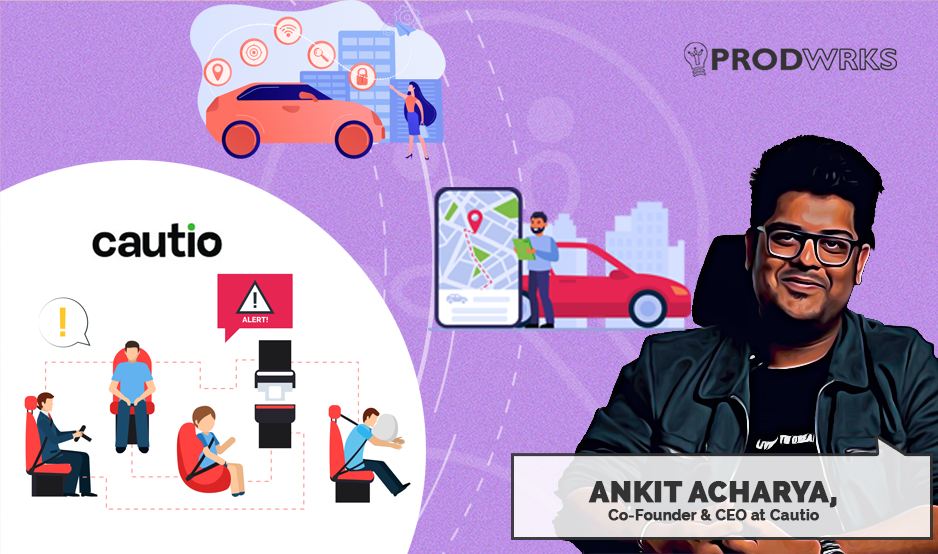
For most fleet operators in India, whether it’s a city cab service, a long-distance bus provider, or a last-mile delivery company, what happens inside their vehicles is often a black box. GPS tracking can tell them where a vehicle is, but not what’s going on inside it. Was a passenger mistreated? Was a risky maneuver made that caused an accident? Was the driver alert? These questions rarely have an answer.
Without evidence, most incidents or accidents go unexplained and thus, unaddressed. The lack of ground-level intelligence leaves operators exposed to risk, reputational damage, and preventable incidents.
These gaps in visibility and a broken accountability loop led Ankit Acharya and Pranjal Nadhani to build Cautio, an AI-powered dashcam and fleet intelligence system designed specifically for commercial vehicles. Cautio provides clients like redBus, Namma Yatri, and Euro Cars with the ability to obtain situational and behavioral signals that determine road safety.
The Bengaluru-based company has raised $2.06M in funding from investors like Antler, AU Small Finance Bank, and 8i Ventures. In this feature story, we explore how Ankit built Cautio to help fleet operators move from reactive damage control to proactive, real-time accountability.
Ankit’s Journey
Before building Cautio, Ankit spent nearly a decade working with platforms like Namma Yatri and Bounce that operate in the urban mobility space. While he witnessed the exponential boom of mobility services in India, he also noticed incidents that suggested a lack of robust safety measures and precautions in the early years.
To understand the depth of the problem, He ran a survey to understand why women would prefer taking cabs over autos. The results? 51% of them revealed that it was easier to jump out of an auto in case something went wrong!
Ankit says, “It could be a discrepancy, it could be just a fight with the driver, or it could be something uncomfortable that the driver has done to you. This is the reality of how women essentially face harassment in public transportation on an everyday basis in India.”
“When that happened, we realized that we couldn't fundamentally solve for it because there was no evidence as to what had happened inside the car. That is when we realised that dashcams or AI-powered dashcams are beautiful tools for us to enable safety. That's what got us started.”
Identifying Gaps in Fleet Safety via On-Ground Research
When Ankit and his team set out to explore the safety challenges of mobility services in India, the problems were far beyond their initial assumptions. For instance, India is not just one of the fastest-growing mobility markets, but also the “accident capital of the world,” with over four lakh accidents reported in 2022, increasing 12% from the previous year.
Through conversations with over 300+ stakeholders, ranging from auto drivers to large fleet operators, Ankit’s team at Cautio discovered troubling patterns that led to incidents. Their research revealed alarming systemic safety failures and technological gaps across the entire fleet ecosystem.
Ankit dived deep into the inefficiencies revealed during his market research.
Problem #1: Inefficient GPS Systems
Traditional vehicle tracking systems rely on GPS, which only shows where a vehicle is, not what’s happening inside. But GPS alone doesn’t ensure accountability inside a vehicle. This leaves fleet operators in the dark about driver behavior or passenger safety, making it hard to assign responsibility when something goes wrong.
Ankit says, “If you're a fleet operator and a passenger has complained about a problem, you won't have evidence and end up paying the driver and the customer, and to get out of it. Now, this is not how mobility should be. And that's what we truly believe.”
Problem #2: Reactive Models
Whether it’s an accident or a passenger issue, fleet managers typically learn about that only after something goes wrong. By then, it’s already too late. That reactive model means they can’t intervene in real time or prevent escalation or a major incident before it happens.
Ankit says, “When there’s an accident or incident, you only find out if the passenger or driver informs you. And by then, something has already gone seriously wrong. But was there a way to understand it in advance? Yes. That is what we wanted to solve. If the solution is proactive instead of reactive, you can catch what’s happening before it escalates.”
Problem #3: Imported Hardware Doesn’t Solve Bharat Problems
The existing fleet safety systems, like dashcams, were mostly imported from China. They were not tailor-made for Indian driving conditions or users. These closed devices offered limited features that did not support local software innovation.
The system has already covered over 4.5 crore kilometers of Indian roads and analyzed nearly 70 lakh safety alerts. Crucially, it isn’t static. Cautio’s AI models continuously retrain themselves based on the real-world footage they capture.
With their made-for-India system, Cautio has detected driver fatigue or distractions in advance and reported 117 cases so far. Ankit emphasizes how the system can not only prevent accidents from happening in the first place, but also help with post-analysis of why an accident happened.
He emphasizes, “It’s very important for your fleet to continuously go through that learning and retraining process to keep getting better with time.”
Building Accountability with AI-Powered Dashcams and Real-Time Driver Monitoring
Ankit explains, “When you share your location with your friends, family, or partners, you're essentially just sharing static data of your vehicle movement. But what we are trying to enable is eyes inside the vehicle so that one could essentially also see if the person inside the car is comfortable or not. This data is much more granular than sharing location, and we're building in more accountability that way.”
The dash cam is equipped with dual-lens powered cameras that come with a driver monitoring system (DMS) and an advanced driver assistance system (ADAS). DMS monitors the driver for signs of distractions or fatigue, along with providing real-time alerts for seatbelts, smoking, and mobile phone usage. ADAS monitors the roads, and the driver receives alerts for road safety.
The device prompts the driver to make the necessary changes. If the same driving behaviour continues even after continuous prompts, a report is generated with photos, videos, and the geolocation. It is sent to the fleet operators’ dashboard. They can use it to communicate the remedial steps with the driver via the inbuilt walkie-talkie or take other necessary action to prevent an incident.
He says, “Since these cameras are AI-powered, all processing happens on the edge. We also have the option to add an additional camera lens for buses to cover the larger area of passengers. The walkie-talkie allows fleet operators to communicate wirelessly with drivers or broadcast messages across the fleet instead of calling each driver individually.”
Software Capabilities for Fleet Monitoring and Incident Response
On the software side, the fleet operators are provided with an admin dashboard where the status of each vehicle they own can be monitored.
The dashboard shows real-time insights: Idle, when their vehicle is online and waiting for someone. Stopped, when the ignition is on but the vehicle has been in standby mode for more than two minutes. Offline, when the ignition is off. And, location error, when a vehicle is in an underground basement or a no-network zone.
Ankit says, “All this information is stored inside the devices, and as soon as the device gets internet connectivity, the information is updated.”
He explains, “If there is an altercation between a passenger and a driver, the system can capture that in real time and create an alert saying there’s a probability of a fight happening inside. This allows fleet operators to act faster than waiting for the problem to occur.”
Customer Acquisition and Satisfaction
Ankit says, “I don't even have a sales team. As of today, 80% of my customers come through word of mouth. My first customer was a company called Wozie Cabs. We got introduced to them by a warm network. We just showed them the prototype of our product back then, and the founder agreed as it made sense to them.”
Ankit explains, “If you are a fleet operator and you speak to another fleet operator about what they are going through, you’ll understand the challenges firsthand. That makes it easier for them to make a case on our behalf, rather than us having to do the hard selling ourselves.”
To measure success, Cautio tracks the number of trips it has protected. “I think that is roughly at round 20 to 25 lakhs,” says Ankit. Along with tracking, if the alerts have come down, they directly indicate improved driver behaviour on the road and towards passengers.
Ankit points out that the company has not lost a single customer to date, where their NPS score is currently at 100 percent. He credits the high NPS score to the people at Cautio who listen and build along with their users.
“Every month, we sync up with all our customers. This allows us to understand where we are making mistakes and where we can do better. And that cycle has been going on for the last seven, eight months, religiously every month.”
Adapting Models to Indian Roads and Operator Needs
Ankit says, “Because in India, a human being, a cow, a dog, a bike, and a car all move on the same road at the same time. So, the camera needs to recognize what is normal and what is not, and understand the permissible limits. That led us to retrain the system in a way that it could accurately identify who or what is moving on the road at any given moment. I think that was one of the most important pieces of feedback we received.”
He explains, “We spent a lot of time refining the designs, and we did it in collaboration with the fleet operators. We worked with them to a point where they now say, ‘This is exactly what we wanted, and this is what we love.’ With their input, we were able to build features like driver monitoring, passenger monitoring, and more.”
Responding to an Industry Moving Toward AI-Powered Safety Systems
Ankit says, “Honestly, I like to operate with fewer distractions,” he says. “But the biggest validation for us is that there are strong tailwinds in the space. This category is going to become mandatory in the next three years.”
“We’re watching every development in the market to make sure we evolve with it. That includes everything from fleet operator needs to customer expectations,” he adds.
“Speak to fleet owners, speak to passengers, speak to drivers,” he says. “I don’t think anyone in this space has ever built it out of empathy, and Cautio is trying to change that.”



